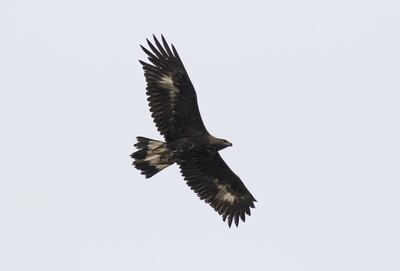The rush to build wind farms to combat climate change is clashing with preservation of one of the US West's most spectacular predators — the golden eagle — as the species teeters on the edge of decline.
The main centre of the problem is Wyoming, a stronghold for golden eagles that soar on wing spans of up to two metres, and a favoured location for wind farms.
As wind turbines grow in number, scientists say deaths from collisions could drive down golden eagle numbers that are considered stable at best.
But climate change could be a greater threat. Rising temperatures are projected to reduce golden eagle breeding ranges by more than 40 per cent this century, the National Audubon Society says.
US bald eagles suffer from lead poisoning — in pictures
“We have some of the best golden eagle populations in Wyoming, but it doesn’t mean the population is not at risk,” said Bryan Bedrosian, conservation director at the Teton Raptor Centre in Wilson, Wyoming.
“As we increase wind development across the US, that risk is increasing.”
Turbine blades hundreds of feet long are among myriad threats to golden eagles, which are routinely shot, poisoned by lead, hit by vehicles and electrocuted on power lines.
The tenuous position of the species contrasts with the conservation success of their cousins, bald eagles, the number of which has quadrupled since 2009.
There are an estimated 346,000 bald eagles in the US, compared with about 40,000 golden eagles, which need much larger areas to survive and are more likely to have trouble with humans.
Federal officials have tried to curb turbine deaths, while avoiding any slowdown in the growth of wind power as an alternative to carbon-emitting fossil fuels, in a key piece of President Joe Biden's climate agenda.
In April, a Florida-based power company pleaded guilty in federal court in Wyoming to criminal violations of wildlife protection laws after its wind turbines killed more than 100 golden eagles in eight states.
It was the third conviction of a major wind company for killing eagles in a decade.
Eagle artwork from beach plastic — in pictures
Despite the deaths, scientists like Mr Bedrosian say more turbines are needed to fight climate change.
He and colleague Charles Preston are finding ways in which wind companies can reduce or offset eagle deaths, such as building in areas less frequented by the birds, improving habitats elsewhere or making power poles less perilous when eagles land.
“It’s robbing Peter to pay Paul, but it’s a start and I think it’s the way to go," Mr Preston said.
“It’s a societal question: is there room for them and us? It's not just golden eagles. They are kind of a window into the bigger picture.”
Illegal shooting is the biggest cause of death, killing about 700 golden eagles a year, federal estimates show.
More than 600 die annually in collisions with cars and wind turbines, and crashing into power lines. About 500 are electrocuted and more than 400 poisoned each year.

Federal officials won't divulge how many eagles are reported killed by wind farms, saying it is sensitive law enforcement information.
The recent criminal prosecution of a subsidiary of NextEra Energy, one of the largest US renewable energy providers, offered a glimpse into the problem's scope.
The company pleaded guilty to three counts of violating the Migratory Bird Treaty Act and was ordered to pay more than $8 million in fines and restitution after killing at least 150 eagles — including more than 100 goldens — at wind farms in Wyoming, California, New Mexico, North Dakota, Colorado, Michigan, Arizona and Illinois.
Government officials said the mortality was probably higher because some turbines killed several eagles and bodies are not always found.
Prosecutors said the company’s failure to take steps to protect eagles or to obtain permits to kill the birds gave it an advantage over competitors that did take such steps, even as NextEra and affiliates received hundreds of millions of dollars in federal tax credits for wind power.
The company remained defiant after the plea deal. NextEra president Rebecca Kujawa said bird collisions with turbines were unavoidable accidents that should not be classed as crimes.
The number of wind turbines nationwide more than doubled over the past decade to almost 72,000, according to US Geological Survey data.
Development of the farms has overlapped prime golden eagle territory in states including Wyoming, Montana, California, Washington and Oregon.
AP contributed to this report.


































